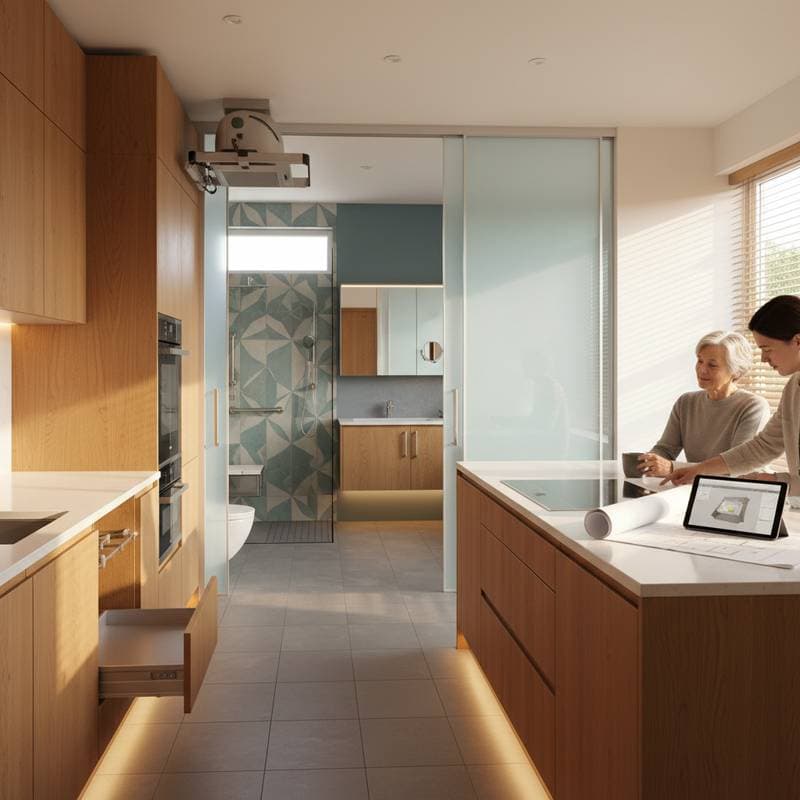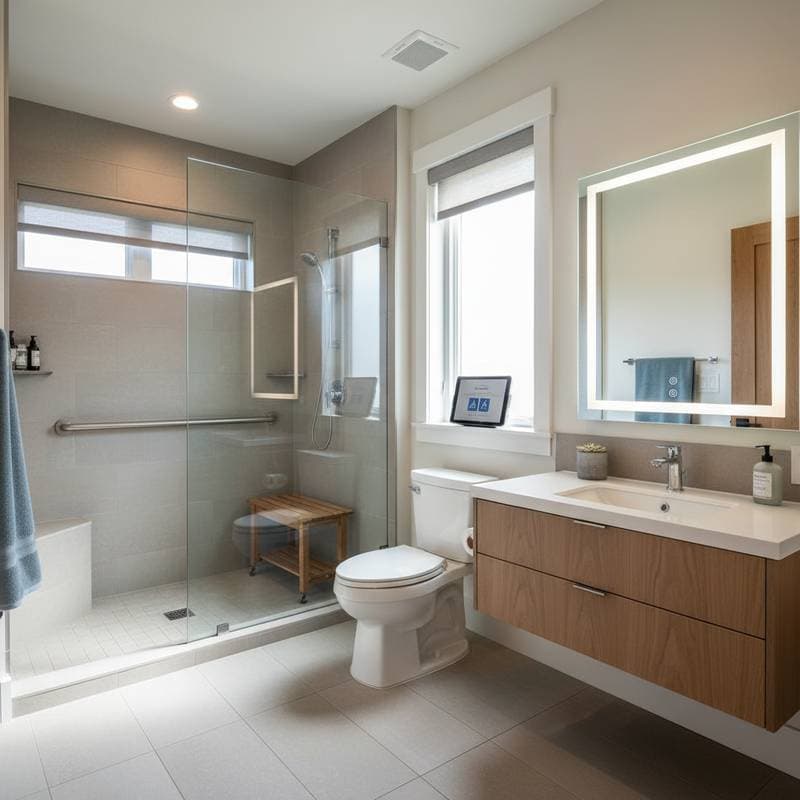Aging in Place: Universal Design Remodel Costs for a Safe and Comfortable Home
Aging in place enables individuals to remain in their cherished homes while preserving independence, safety, and comfort. Thoughtful remodeling incorporates universal design features that simplify navigation, enhance security, and boost livability over time. This guide details universal design elements, typical remodeling expenses, strategic investment areas, and the value of professional involvement.
Understanding Universal Design and Aging in Place
Universal design develops environments suitable for all people, irrespective of age, mobility levels, or abilities. It emphasizes safety, accessibility, and usability while upholding style and comfort. Key elements include zero-step entrances, expanded doorways measuring at least 36 inches wide, lever-style handles, and showers without barriers to support lifelong home usability.
Why It Matters
Remodeling for aging in place minimizes the necessity for relocation and offsets expenses associated with assisted living facilities. Such modifications often elevate property values, as accessibility appeals to an expanding group of homeowners seeking sustained independence.
Core Principles
- Accessibility: Facilitate straightforward entry and circulation within the residence.
- Safety: Minimize fall hazards through adequate illumination, stable installations, and secure elements.
- Comfort: Incorporate adjustable components and ergonomic configurations.
- Flexibility: Develop adaptable areas that adjust to changing requirements.
- Aesthetics: Integrate functionality seamlessly with contemporary aesthetics.
Where to Start for the Greatest Impact
Prioritize Safety and Mobility
Address high-risk zones initially, such as bathrooms, staircases, and entrances. Convert traditional bathtubs to walk-in showers with built-in seating, and install non-slip flooring materials rated for wet environments to lower immediate dangers.
Improve Lighting and Visibility
Implement layered illumination strategies for optimal effect. Position task lights above kitchen counters for precise work, install motion-activated sensors in corridors for automatic activation, and use soft ambient fixtures in communal spaces. Enhanced, evenly distributed lighting reduces fall incidents and elevates overall well-being.
Simplify Access Throughout the Home
Substitute traditional round doorknobs with easy-grip lever handles that require minimal force. Opt for rocker-style light switches operable with a closed fist. Ensure thresholds align flush with adjacent flooring to eliminate tripping points, and integrate smart home systems for voice-activated controls on blinds and appliances.
Design Ideas for Every Room
Bathrooms
Emphasize layouts free of barriers and simple to maintain. Select large-format porcelain tiles with reduced grout lines to enhance grip and ease cleaning. Mount reinforced grab bars, capable of supporting 250 pounds or more, adjacent to toilets and within showers. Incorporate a foldable shower bench for seated bathing, and select finishes such as brushed nickel faucets or matte black hardware to merge safety with elegant design.
Kitchens
Configure the kitchen to accommodate varied heights and abilities. Designate a countertop section adjustable from 34 inches high for wheelchair use during meal preparation. Replace fixed lower cabinets with pull-out shelves on smooth glides. Install wall ovens with side-hinged doors and dishwashers featuring pull-out drawers to lessen bending and stretching. Choose slip-resistant yet cushioned flooring options like luxury vinyl planks or cork tiles for prolonged standing comfort.
Living Areas
Promote open floor plans to streamline movement. Select furnishings with rounded corners and weighted bases to prevent tipping. Maintain clear pathways of no less than 36 inches wide between furniture arrangements. Anchor area rugs using latex-backed pads or double-sided tape to avoid slippage on hard surfaces.
Bedrooms
Equip closets with height-adjustable rods and pull-down shelving units for convenient reach. Locate electrical outlets and light switches between 15 and 48 inches from the floor. Place a bedside emergency call button or intercom system within arm's reach. If feasible, convert or add a main-level bedroom to bypass stair navigation entirely.
Entryways
Establish a zero-step entry as the cornerstone of accessibility. Construct covered porticos with textured concrete or composite decking to shield against rain and snow. Integrate motion-sensing exterior lights for nighttime arrivals. Install 36-inch-wide doors with sweeps and thresholds no higher than half an inch to accommodate walkers or wheelchairs smoothly.
Money-Saving Tips and ROI Insights
Combine Projects Strategically
Group interconnected upgrades to cut labor expenses. For instance, during a bathroom renovation, simultaneously widen adjacent doorways and upgrade hallway lighting. This approach avoids repeated disruptions and consolidates permitting fees.
Use Durable, Low-Maintenance Materials
Select resilient options that curb ongoing expenses. Quartz surfaces resist stains without sealing, while vinyl composite flooring withstands moisture better than hardwood. Stainless steel fixtures endure daily use with minimal polishing.
Seek Grants and Local Incentives
Explore community programs providing rebates or subsidized loans for accessibility enhancements. Many regions support installations like modular ramps, stair glides, or curbless shower conversions through aging services departments.
Focus on Universal Appeal
Prioritize neutral palettes and sleek lines to boost marketability. Contemporary grab bars in chrome or oil-rubbed bronze mimic decorative towel rods, ensuring the design integrates into diverse interior schemes without appearing clinical.
Safety, Permits, and Code Compliance
Confirm local permit obligations prior to commencing significant alterations. Modifications to electrical wiring or plumbing lines typically necessitate inspections for safety. Exterior ramps require adherence to guidelines specifying a 1:12 slope ratio, 36-inch widths, and continuous handrails. Engage licensed contractors to guarantee adherence and avert expensive corrections.
Prioritize safety in every choice. Opt for surfaces with a coefficient of friction above 0.6 for traction, install 100-watt equivalent LED bulbs for illumination, and secure all hardware with corrosion-resistant anchors. Minor tweaks, such as adding high-contrast nosing to stair edges, significantly curb accident risks.
Maintenance and Longevity
Universal design installations endure for generations when constructed properly. Favor materials engineered against humidity, rust, and abrasion, such as powder-coated metal rails and sealed composite decking. Conduct annual evaluations of grab bars for secure mounting, flooring for wear patterns, lighting for bulb efficacy, and ramps for surface integrity. Employ pH-neutral cleaners on textured floors to preserve slip resistance, and upgrade to daylight-spectrum LEDs as visual acuity diminishes.
When to Hire a Certified Aging-in-Place Specialist
A certified aging-in-place specialist (CAPS) possesses expertise in merging design principles with safety protocols. These professionals evaluate existing structures, propose tailored enhancements, and manage regulatory approvals. Verify credentials through the National Association of Home Builders, examine past projects, and request client testimonials prior to engagement.
Collaboration with a CAPS yields renovations that harmonize utility and elegance, steering clear of utilitarian appearances. They forecast evolving demands, like provisions for mobility aids or caregiver accommodations, thereby forestalling subsequent overhauls.
Common Questions About Aging in Place Remodeling
What is the difference between universal design and ADA compliance?
Universal design serves broad user needs proactively, whereas ADA compliance enforces minimum standards for public accommodations. Residential applications benefit from universal design's adaptable, inclusive approach.
Do universal design features hurt resale value?
Quite the opposite. Tastefully integrated elements attract a wider buyer pool valuing enduring usability and safety.
How long does a bathroom remodel take?
Accessible bathroom projects generally span two to four weeks, influenced by the scope of plumbing rerouting and supply chain factors.
Can I add accessibility features to a small bathroom?
Absolutely. Compact innovations such as wall-mounted vanities, sliding pocket doors, and hinged support benches optimize space while ensuring functionality.
Are ramps the only solution for entry access?
No. Alternatives include gently sloped pathways with handrails, vertical platform lifts for modest rises, or redesigned stoops to achieve seamless transitions.
Sustaining Accessibility Over Time
Following completion of renovations, prioritize ongoing vigilance to uphold safety and ease. Perform yearly walkthroughs to identify deterioration or emerging needs. Refresh scuffed flooring promptly, reinforce loosening fixtures, and recalibrate lighting to match current vision requirements.
Aging in place fosters a residence that evolves alongside its occupants. Strategic universal design investments deliver reassurance, seamless mobility, and sustained livability, all while preserving aesthetic appeal. This forward-thinking approach empowers confident, independent enjoyment of home life for decades ahead.











